Leaders: Alan Rayner and Helena Crouch
On a fine autumn day, 15 members assembled for one of Alan’s popular fungal forays. Our venue, East Harptree Woods, is a Forestry England conifer plantation on the site of former lead mining activity. Smitham Chimney still stands, as a tall reminder of the industrial history, and much of the ground is “gruffy”. A Red Admiral fluttered around us during the health and safety briefing, in which Helena reminded everyone that on a previous BNHS walk here she stepped backwards into a ditch, asking members to take more care.
Setting off along the main ride, we soon found Sulphur Tuft (Hypholoma fasciculare), the Scurfy Twiglet (Tubaria furfuracea) and a Snapping Bonnet (Mycena vitilis), a neat little toadstool with a flexible stem. In a recently felled area, we saw our first False Chanterelles (Hygrophoropsis aurantiaca), a common species of acid sites. Many of the colonising plant species here also indicated acidic soil, including Foxglove (Digitalis purpurea), Wood Sorrel (Oxalis acetosella), Sheep’s Sorrel (Rumex acetosella) and Heath Bedstraw (Galium saxatile). Some orange blobs on a stick were swiftly identified as the Common Jelly Spot (Dacrymyces stillatus). Entering the woodland east of the ride, we found a splendid Deer Shield (Pluteus cervinus), its brown cap with a slight umbo, and also a group of the relatively large Common Bonnet (Mycena galericulata).
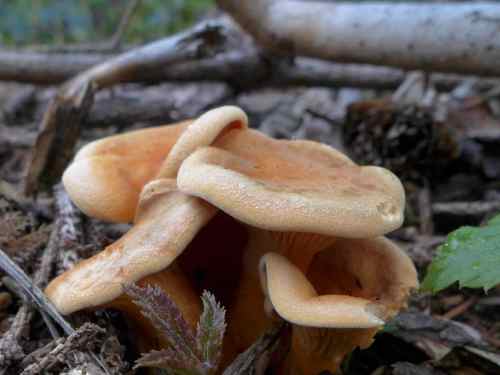
False Chanterelle (Hygrophoropsis aurantiaca) © Helena Crouch
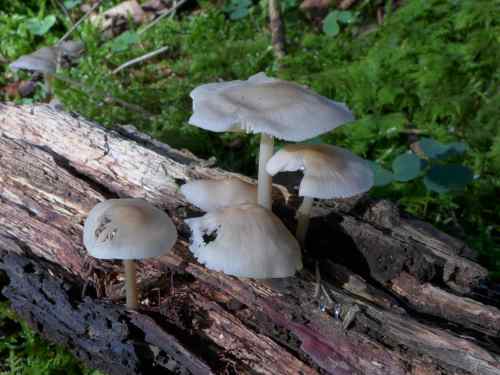
Common Bonnet (Mycena galericulata) © Helena Crouch
On fallen wood, we found a few different bracket fungi: Blushing Bracket (Daedaleopsis confragosa), Turkeytail (Trametes versicolor), Alder Bracket (Inonotus radiatus), a Poplar Bracket (Oxyporus populinus) on Sycamore (a common host), a Blackfoot Polypore (Polyporus leptocephalus) and a group of little white Variable Oysterlings (Crepidotus variabilis), which are bracket-like tiny toadstools without stems.
Examining a smart specimen of a Brown Rollrim (Paxillus involutus), Alan explained that this common species is cumulatively poisonous and can be eaten with no apparent reaction, the toxins accumulating in the body until reaching a lethal level. After finding the common Wood Woollyfoot (Collybia peronata) and Milking Bonnet (Mycena galopus), we were introduced to the brown-capped Whitelaced Shank (Megacollybia platyphylla): Alan excavated the stout white mycelial cords which can ramify for great distances through the substrate. As we returned to the main path, a grey-capped Brittlegill was bravely tasted and pronounced to be a Hotlips Brittlegill (Russula acrifolia).
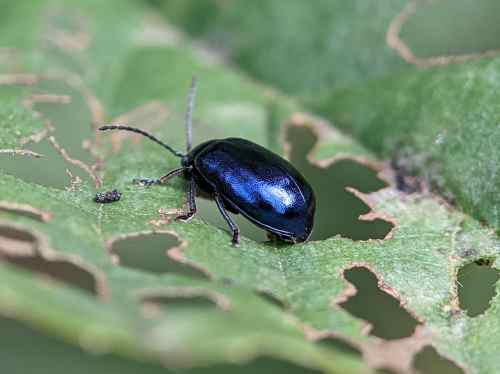
Alder Leaf Beetle (Agelastica alni) on Alder © Dave Pole
On a stump nearby, a group of fungi which looked like Sulphur Tuft, yet with dusky pink caps, were examined: these were in fact Brick Tufts (Hypholoma lateritium). Heading for the chimney, we stopped to study a Deceiver (Laccaria laccata) and to look at metallic dark blue Alder Leaf Beetles (Agelastica alni), which feed on alder and other tree species and has increased dramtically in recent years. We passed Heather (Calluna vulgaris), Western Gorse (Ulex gallii) and Purple Moor-grass (Molinia caerulea), more plants typical of acid soils.
A short shower just as we reached the pond and chimney was unfortunate, as was the fact that, despite the earlier warnings, Alan fell in the very same ditch that his co-leader had previously stepped into! Luckily he emerged unscathed, and lunch became the top priority – the shower passed and we sat under conifers on a grassy mound of mining spoil, watched by a kestrel and visited by dragonflies. Beside the mound, we found a slimy-capped bolete, a Slippery Jack (Suillus luteus), which Alan explained was unusual amongst boletes in retaining a distinctive ring on the stem.
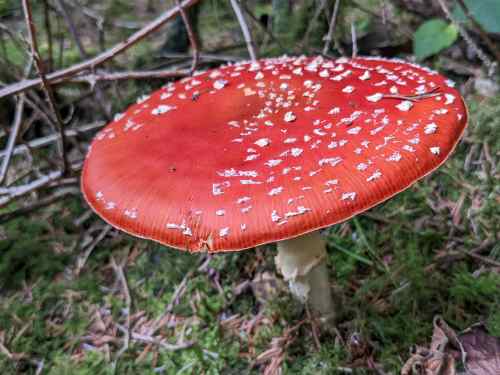
Fly agaric (Amanita muscaria) © Helena Crouch
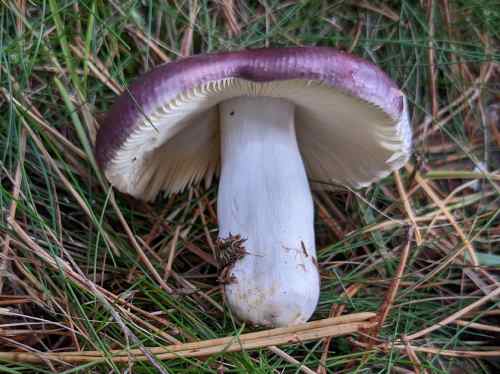
Humpback Brittlegill (Russula caerulea) © Helena Crouch
Suitably refreshed, we explored under pines on the mound, finding two smart brittlegills with dark caps: the Primrose Brittlegill (Russula sardonia) with a pinkish stem and the Humpback Brittlegill (R. caerulea) with a distinct umbo. A little later we also found the Ochre Brittlegill (R. ochroleuca). As a deviation from fungi, Helena showed members a patch of bare toxic soil which was covered in a dark green minute-piled carpet. This was the rare Lead Moss (Ditrichum plumbicola), found at only a few former lead mining sites in the country. On the return to the car park, two huge fresh Fly Agarics (Amanita muscaria) were spotted, definitely the most stunning toadstools of the day. Nearby were hundreds more False Chanterelles, which were without doubt the most numerous species seen, exhibiting a confusing array of shapes and forms. It had been a brilliant day, with an interesting but not overwhelming selection of fungi due to the prolonged recent dry weather. As always, the company was excellent, with members sharing their diverse and extensive knowledge of the natural world.
Helena Crouch


Recent Comments